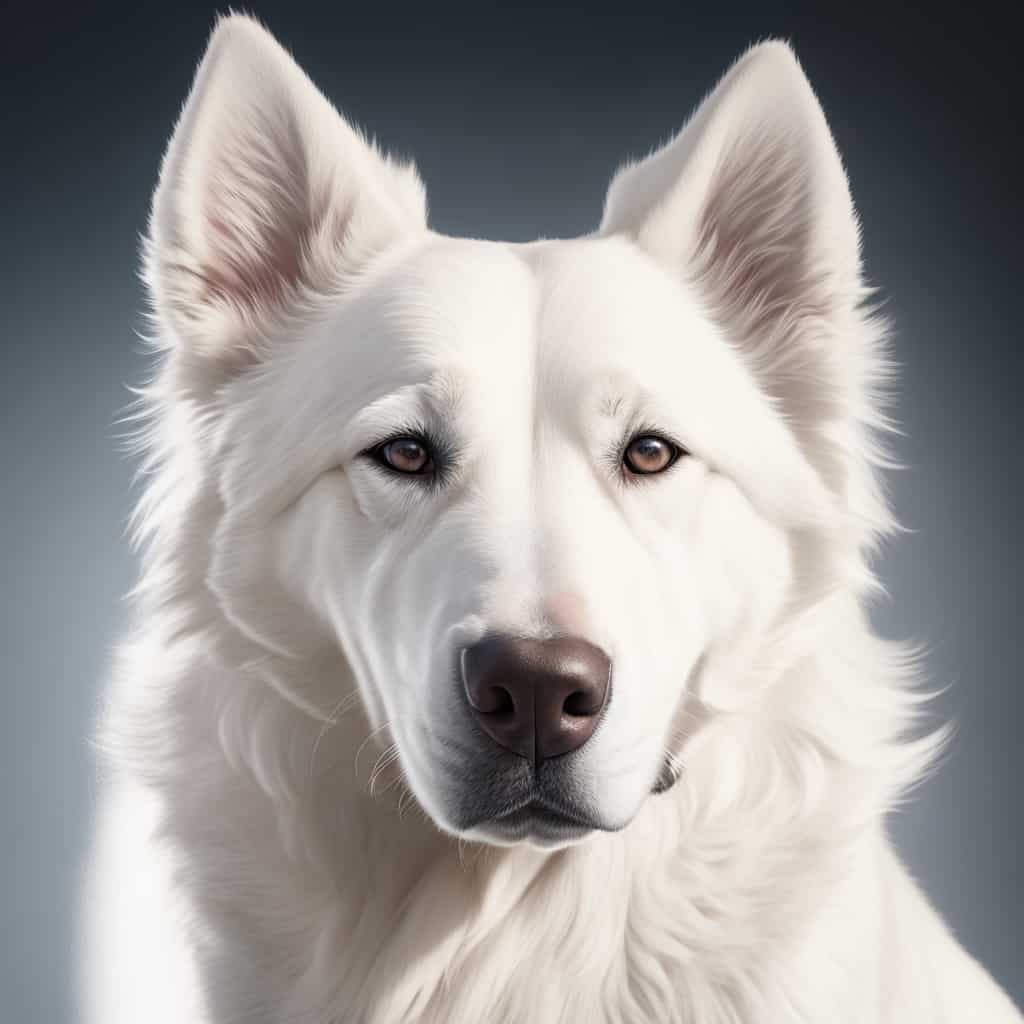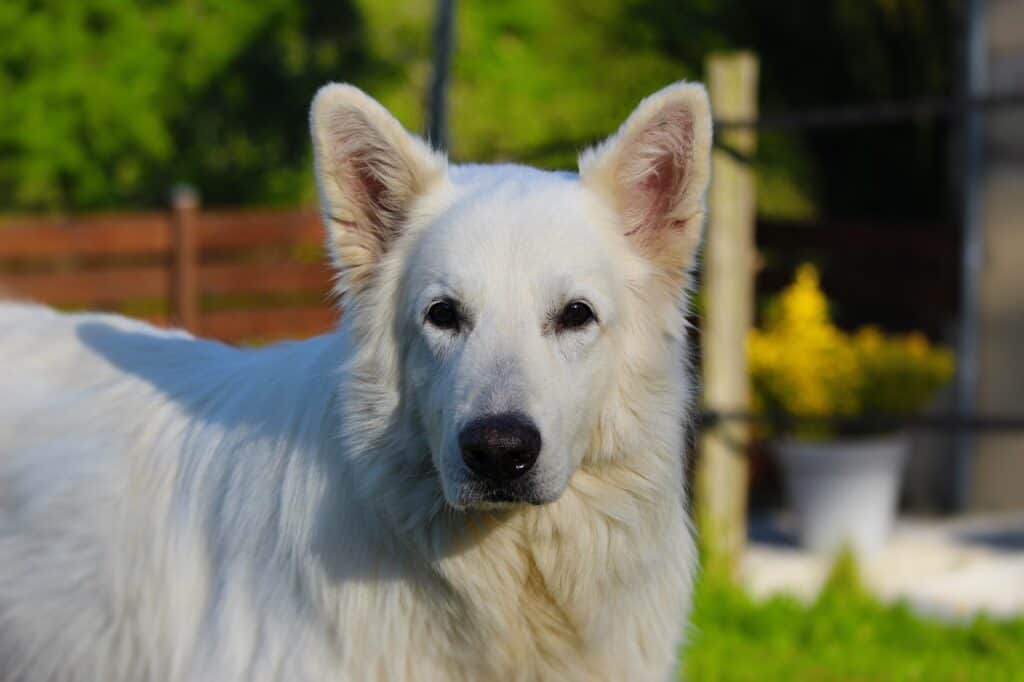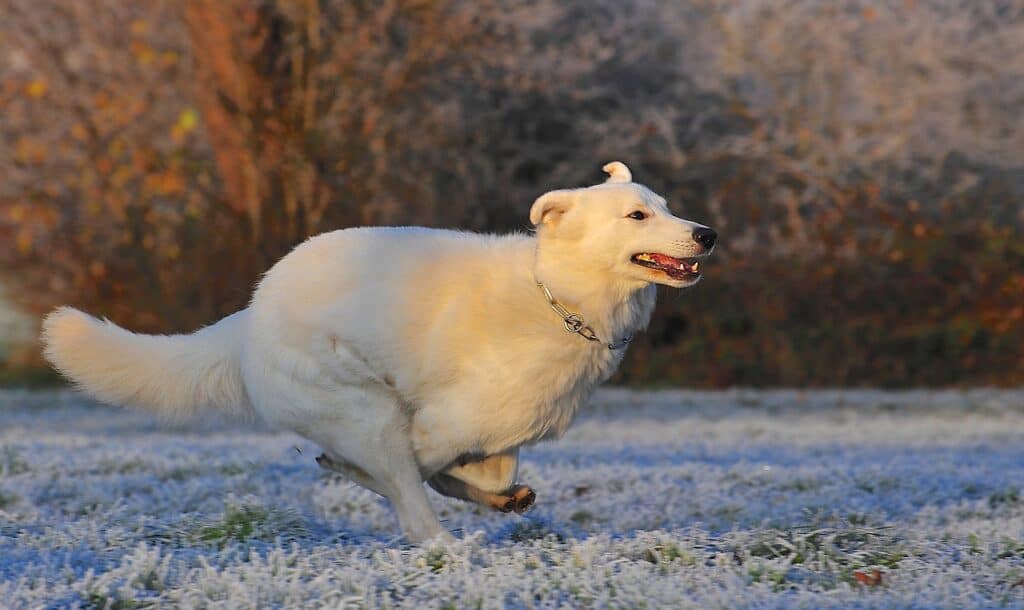The White Swiss Shepherd Dog, a picture of elegance, unwavering loyalty, and remarkable intelligence, has captured the hearts of dog lovers and families alike. With origins in Switzerland, striking physical attributes, and a unique set of temperament traits, this breed has established itself as a beloved companion and a dependable working dog.

| Category (Explanation) | Breed Information |
|---|---|
| Year of Breed Conception | Late 19th century |
| Country of Origin | Switzerland |
| Weight (lbs & kg) (Male) | 66-88 lbs (30-40 kg) |
| Weight (lbs & kg) (Female) | 55-77 lbs (25-35 kg) |
| Coat Type | Double coat with a white, thick, medium-length outer coat |
| Color Variations | White |
| Shedding Level (Low, Moderate, High) | Moderate |
| Height (cm & in) | 22-26 inches (55-66 cm) |
| Breed Size | Large |
| Trainability (Low, Moderate, High) | High |
| Mental Needs (Low, Moderate, High) | Moderate |
| Intelligence Level (Low, Moderate, High) | High |
| Energy Level (Low, Moderate, High) | High |
| Agility (Low, Moderate, High) | High |
| Loyalty (Low, Moderate, High) | High |
| Playfulness (Low, Moderate, High) | Moderate |
| Exercise Needs | Regular exercise and mental stimulation |
| Guarding Proficiency (Low, Moderate, High) | High |
| Sociability with Children (Low, Moderate, High) | High |
| Barking Level (Low, Moderate, High) | Moderate |
| Digging Tendency (Low, Moderate, High) | Low |
| Destructive Behavior (Low, Moderate, High) | Low |
| Drooling Level (Low, Moderate, High) | Low |
| Obedience Level (Low, Moderate, High) | High |
| Apartment Friendly (Yes/No) | Can adapt to apartment living with sufficient exercise |
| Inherent Prey Drive | High |
| Physical Risk to Others (Low, Moderate, High) | Low |
| Travel Fatality Risk (Low, Moderate, High) | Low |
| Allergen Potential | Low |
| Health Concerns (List of Common Health Concerns) | Hip Dysplasia, Eye Issues, Elbow Dysplasia |
| Average Life Expectancy (Life Expectancy in Years) | 12-14 years |
Woof Mastery is reader supported and our articles may contain affiliate links.
Instead of running third party ads that we have no control of we only use links from high-quality companies we are directly partnered with. Making use of these links come at no cost to you our reader, and in many cases have the extra benefit of discounted rates or sign up bonuses.
If you’re interested you can read more about our affiliate policy here.
We appreciate your support and always insure that the products and services we recommend are high-quality, helpful and relevant to the subject at hand!
The White Swiss Shepherd Dog, a relative of the German Shepherd, shares a history of herding and service. These dogs were developed for herding tasks and originated in Switzerland.
Their name, “White Swiss Shepherd,” refers to their stunning white coat, which distinguishes them from the more common German Shepherd breed. These dogs are known for their intelligence and loyalty.
Today, White Swiss Shepherd Dogs are cherished for their versatile skills, excelling in herding, search and rescue, and as devoted family pets.

The White Swiss Shepherd Dog is special for its stunning appearance and adaptability. These dogs share the intelligence and loyalty of the German Shepherd. Their versatile nature makes them outstanding working dogs and devoted companions.
White Swiss Shepherd Dogs, similar to German Shepherds, have a tradition rooted in herding and working roles. Their herding capabilities, intelligence, and protective instincts made them valuable in managing livestock. Today, they continue to serve as versatile working dogs, loyal family companions, and reliable protectors, embodying their heritage as dependable working dogs.
White Swiss Shepherd Dogs share their personalities with the German Shepherd. They are known for their intelligence, loyalty, and versatility. These dogs excel in various working roles, from herding to protection.
Their intelligence and trainability make them quick learners, and their affectionate nature with their families is evident. White Swiss Shepherd Dogs are characterized by their versatility, devotion, and a strong sense of responsibility, epitomizing the perfect blend of intelligence and adaptability.
White Swiss Shepherd Dogs, like German Shepherds, are intelligent, loyal, and protective. They can be reserved with strangers and need early socialization to ensure balanced protective instincts.
Mental and physical exercise is important for their well-being.
White Swiss Shepherd Dogs, similar to German Shepherds, are medium to large-sized dogs with a well-proportioned and athletic build. They have a strong, square-shaped head with a straight, powerful muzzle and expressive, almond-shaped eyes. Ears are pointed and stand erect.
They have a double coat with a dense, straight, and weather-resistant outer coat. Coat colors can include black and tan, sable, or solid black. Their tail is bushy and typically hangs down.
Males typically stand between 24 to 26 inches (61-66 cm) at the shoulder and weigh between 75 to 95 pounds (34-43 kg), while females are slightly smaller and lighter.
White Swiss Shepherd Dogs have a powerful and graceful appearance, reflecting their history as herding and working dogs.
White Swiss Shepherd Dogs, like German Shepherds, typically come in black and tan, sable, and solid black colors.
White Swiss Shepherd Dogs, similar to German Shepherds, may have bicolor or saddleback patterns, typically in black and tan, sable, or solid black.
White Swiss Shepherd Dogs have a moderate shedding level. They shed consistently, with increased shedding during seasonal changes. Regular grooming and brushing can help control shedding and keep their coat in good condition.
White Swiss Shepherd Dogs have a medium-length double coat that requires regular grooming to keep it healthy and minimize shedding. Grooming habits for this breed include:
1. Brushing: Regular brushing, at least once or twice a week, is essential to prevent matting and remove loose fur. Use a slicker brush or an undercoat rake for thorough grooming.
2. Bathing: Bathe White Swiss Shepherd Dogs when necessary using a dog-specific shampoo and ensure thorough rinsing.
3. Ears: Check and clean their ears regularly to prevent wax buildup or infections with a veterinarian-recommended ear cleaning solution.
4. Nails: Keep their nails trimmed to a comfortable length to maintain proper gait and prevent discomfort.
5. Teeth: Brush their teeth regularly to ensure dental health and prevent bad breath. Dental chews or toys can be beneficial.
6. Tail and Paw Care: Maintain cleanliness in the tail and paw areas, inspecting for any signs of irritation or injury.
White Swiss Shepherd Dogs have a high activity level and thrive on physical and mental challenges. Key points about their activity level include:
1. Exercise Needs: White Swiss Shepherd Dogs require daily exercise to stay happy and healthy. Activities can include long walks, runs, and interactive play.
2. Energy Level: They have high energy levels, especially when young. Regular exercise helps channel their energy in positive ways.
3. Herding Heritage: Historically, White Swiss Shepherd Dogs were bred for herding and guarding tasks. They excel in activities like obedience training, agility, and herding.
4. Mental Stimulation: In addition to physical exercise, mental challenges through obedience training and puzzle games are essential to keep them engaged.
5. Outdoor Enthusiasts: They enjoy outdoor activities and make excellent companions for hikers and runners.
King Shepherds are highly intelligent dogs known for their problem-solving abilities. Here are some key points about their intelligence:
King Shepherds’ exceptional intelligence and versatility make them excel in a variety of roles. Training, socialization, and mental stimulation are vital for their development and well-being.
White Swiss Shepherd Dogs, similar to German Shepherds, are highly intelligent and require mental stimulation. Engage them in activities like obedience training, puzzle toys, and interactive games to keep their minds sharp.
Social Interaction: They are social dogs and need regular interaction with their human family. Loneliness can lead to anxiety or destructive behavior, so provide companionship and attention.
Exercise: Mental exercise is equally important. Offer them tasks that challenge their problem-solving skills.
Training and Obedience: White Swiss Shepherd Dogs thrive on obedience training and activities that engage their minds. Consistent, positive-reinforcement training is effective in shaping their behavior.
Enter The Woof Mastery

Before welcoming a White Swiss Shepherd Dog into your home, consider the following:
1. Activity Level: White Swiss Shepherds are active and need regular exercise and mental stimulation.
2. Training Commitment: They are intelligent and require consistent training and socialization.
3. Space: They need space to move around comfortably, making them better suited for homes with yards.
4. Shedding: Regular grooming is important to manage their coat, which sheds moderately.
5. Work or Activities: Many White Swiss Shepherds enjoy tasks or dog sports to keep them engaged.
White Swiss Shepherd Dogs, while not as large as some breeds, may pose a physical risk to others if not properly socialized, trained, or managed. The risk assessment factors include:
1. Protective Instinct: White Swiss Shepherd Dogs may have a protective instinct, especially towards their family or territory. Proper training is essential to manage this instinct.
2. Socialization: Early and thorough socialization is crucial to ensure White Swiss Shepherd Dogs are comfortable around people and other animals. Poor socialization can lead to fear or aggression.
3. Training: Obedience training is essential to teach White Swiss Shepherd Dogs appropriate behavior and ensure they respond to commands. Well-trained dogs are less likely to engage in aggressive behavior.
4. Owner Responsibility: Responsible ownership involves being aware of the dog’s behavior and taking necessary precautions in public settings.
5. Breed-Specific Legislation (BSL): White Swiss Shepherd Dogs may not be commonly subject to BSL, but owners should be aware of local regulations.
6. Individual Variability: Each dog is unique, and behavior can vary. Responsible ownership, proper training, and socialization are key to minimizing the potential physical risk to others.
White Swiss Shepherd Dogs, like German Shepherds, are often good with children. They are protective, loyal, and can be gentle and patient. Their interactions with kids are generally positive when properly socialized and trained.
White Swiss Shepherd Dogs, like German Shepherds, are generally capable swimmers. Their strong and muscular build allows them to stay buoyant in the water. Many White Swiss Shepherd Dogs may have a natural instinct for swimming and enjoy it. As with any breed, individual comfort levels with water activities can differ, so close supervision is important.
Early and positive training will help your White Swiss Shepherd Dog puppy become a well-behaved and devoted companion.
White Swiss Shepherd Dogs are generally moderate in terms of noisiness. They may bark to alert their owners, but they are not known to be excessively vocal. Their barking is often responsive to specific stimuli.
White Swiss Shepherd Dogs thrive in homes that provide:
Challenges:
Traveling with White Swiss Shepherd Dogs involves these considerations:
White Swiss Shepherd Dogs are generally healthy, but they may be prone to certain health concerns, including:
Proper nutrition is vital for White Swiss Shepherd Dogs. Follow these nutritional habits:
Proper nutrition is essential for the health and well-being of White Swiss Shepherd Dogs.
Breed-specific laws (BSL) can affect White Swiss Shepherd Dogs in specific areas, with regulations varying by jurisdiction. Common BSL restrictions that White Swiss Shepherd Dogs may face include:
BSL is typically motivated by concerns about public safety and perceived risks associated with specific breeds, including White Swiss Shepherd Dogs. However, it’s important to note that White Swiss Shepherd Dogs are not inherently aggressive, and BSL may affect them due to their physical resemblance to breeds that are sometimes included in these laws.
BSL is a contentious subject, and many advocates argue that it unfairly targets breeds rather than addressing individual dog behavior. They emphasize that responsible ownership, training, and education should be emphasized instead of breed-specific restrictions.
To determine if there are breed-specific laws or restrictions regarding White Swiss Shepherd Dogs in your area, you should check with your local animal control or government authorities. Be aware of and comply with any local regulations to ensure that you are in compliance with the law while owning a White Swiss Shepherd Dog.
Woof Mastery is reader supported and our articles may contain affiliate links.
Instead of running third party ads that we have no control of we only use links from high-quality companies we are directly partnered with. Making use of these links come at no cost to you our reader, and in many cases have the extra benefit of discounted rates or sign up bonuses.
If you’re interested you can read more about our affiliate policy here.
We appreciate your support and always insure that the products and services we recommend are high-quality, helpful and relevant to the subject at hand!
Myth 1: White Swiss Shepherd Dogs are Albino German Shepherds
Truth: White Swiss Shepherd Dogs are a separate breed with distinct characteristics. Their coat color is due to a specific genetic trait.
Myth 2: They are Aggressive Due to Color
Truth: Coat color doesn’t determine temperament. White Swiss Shepherd Dogs have a friendly and loyal nature when properly trained and socialized.
White Swiss Shepherd Dogs, also known as Berger Blanc Suisse, are recognized for their beauty and versatility, and some notable examples include:
These White Swiss Shepherd Dogs have showcased the breed’s elegance, intelligence, and versatility in various roles, from conformation to service and search and rescue work.
White Swiss Shepherd Dogs, similar to German Shepherds, have been owned by families and dog enthusiasts who value their loyalty and versatility. While specific historical owners may not be widely documented, these dogs have excelled in various roles.
White Swiss Shepherd Dogs, like all breeds, face certain challenges and dangers. Some of the greatest dangers and concerns for the breed include:
By understanding these challenges and providing responsible ownership and care, many of these dangers can be mitigated to ensure the well-being of White Swiss Shepherd Dogs.
The White Swiss Shepherd Dog, also known as the Berger Blanc Suisse, shares its genetic heritage with the German Shepherd. It was bred for its white coat color while preserving the German Shepherd’s working abilities. The breed’s development focused on creating a distinct appearance while retaining the German Shepherd’s versatility.
The White Swiss Shepherd Dog, known for its grace and intelligence, is a breed that excels in various roles, from herding to search and rescue. Their gentle nature and stunning white coats have made them cherished companions.
Owning a White Swiss Shepherd Dog entails providing mental and physical stimulation, grooming, and regular veterinary care. Responsible ownership includes addressing potential health concerns and embracing their herding instincts through training.
With their elegant white coats and calm demeanor, White Swiss Shepherd Dogs continue to make a significant impact as loyal working partners and beloved family members.